The creation of National Parks has been described as “America’s Best Idea.” Considering the beauty and majesty of these lands, along with their ecological, cultural, and historical importance, it’s hard to argue.
Thirty states have at least one national park within their borders, but which state has the most? Which state features the largest park? How about the smallest? Where is the oldest park? Which state boasts the newest national park? We’re going to tackle all those questions and more. Let’s explore “America’s Best Idea,” starting with the number of national parks in each state.
| State | Number of National Parks |
|---|---|
| Alabama | 0 |
| Alaska | 8 |
| Arizona | 3 |
| Arkansas | 1 |
| California | 9 |
| Colorado | 4 |
| Connecticut | 0 |
| Delaware | 0 |
| Florida | 3 |
| Georgia | 0 |
| Hawaii | 2 |
| Idaho | 1 |
| Illinois | 0 |
| Indiana | 1 |
| Iowa | 0 |
| Kansas | 0 |
| Kentucky | 1 |
| Louisiana | 0 |
| Maine | 1 |
| Maryland | 0 |
| Massachusetts | 0 |
| Michigan | 1 |
| Minnesota | 1 |
| Mississippi | 0 |
| Missouri | 1 |
| Montana | 2 |
| Nebraska | 0 |
| Nevada | 2 |
| New Hampshire | 0 |
| New Jersey | 0 |
| New Mexico | 2 |
| New York | 0 |
| North Carolina | 1 |
| North Dakota | 1 |
| Ohio | 1 |
| Oklahoma | 0 |
| Oregon | 1 |
| Pennsylvania | 0 |
| Rhode Island | 0 |
| South Carolina | 1 |
| South Dakota | 2 |
| Tennessee | 1 |
| Texas | 2 |
| Utah | 5 |
| Vermont | 0 |
| Virginia | 1 |
| Washington | 3 |
| West Virginia | 1 |
| Wisconsin | 0 |
| Wyoming | 2 |
The State With the Most National Parks
California is home to nine national parks, more than any other U.S. state. The national parks in The Golden State include:
- Channel Islands National Park
- Death Valley National Park
- Joshua Tree National Park
- Kings Canyon National Park
- Lassen Volcanic National Park
- Pinnacles National Park
- Redwood National Park
- Sequoia National Park
- Yosemite National Park
California’s national parks have a stunning range of ecological diversity. Death Valley National Park, for example, is the largest national park in the continental United States. While California shares the park with Nevada, over 96% of the park’s three million acres are within California’s borders. It is the hottest, driest, and lowest national park (Death Valley has the lowest elevation in North America at 282 feet below sea level).
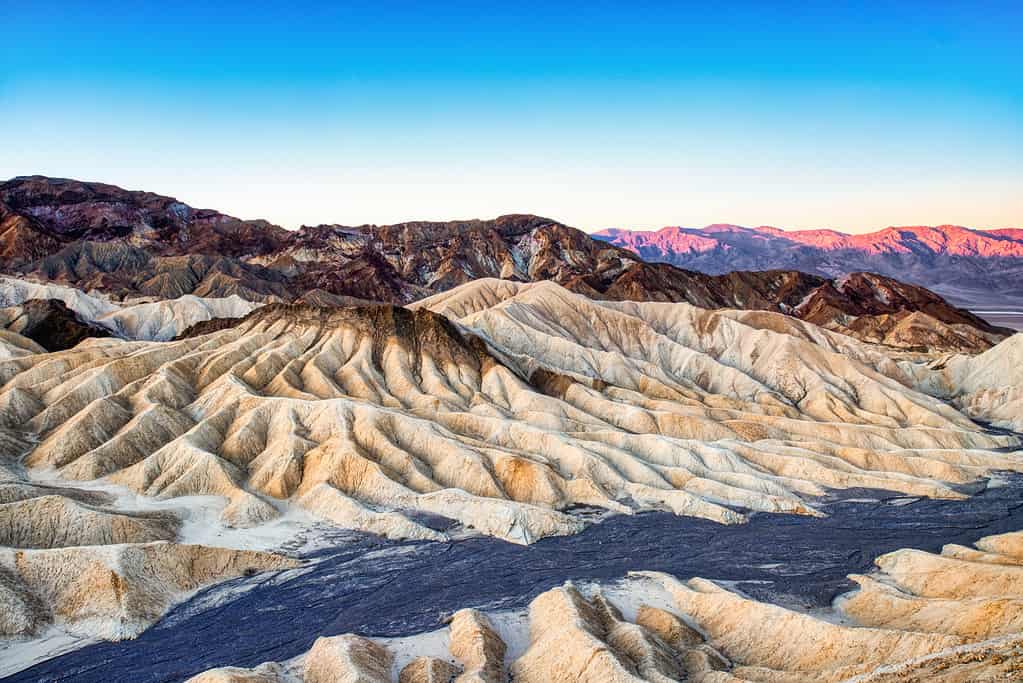
The badlands view from Zabriskie Point reveals just how desolate Death Valley National Park really is.
©iStock.com/roman_slavik
The barren landscape of Death Valley National Park certainly contrasts with the massive trees found at Kings Canyon and Sequoia National Parks. The giant sequoias are the largest trees in the world by volume. These mammoth trees grow 250-300 feet tall with a circumference of over 94 feet.
You can find all this, and much, much more in California’s nine national parks, the most of any U.S. state.
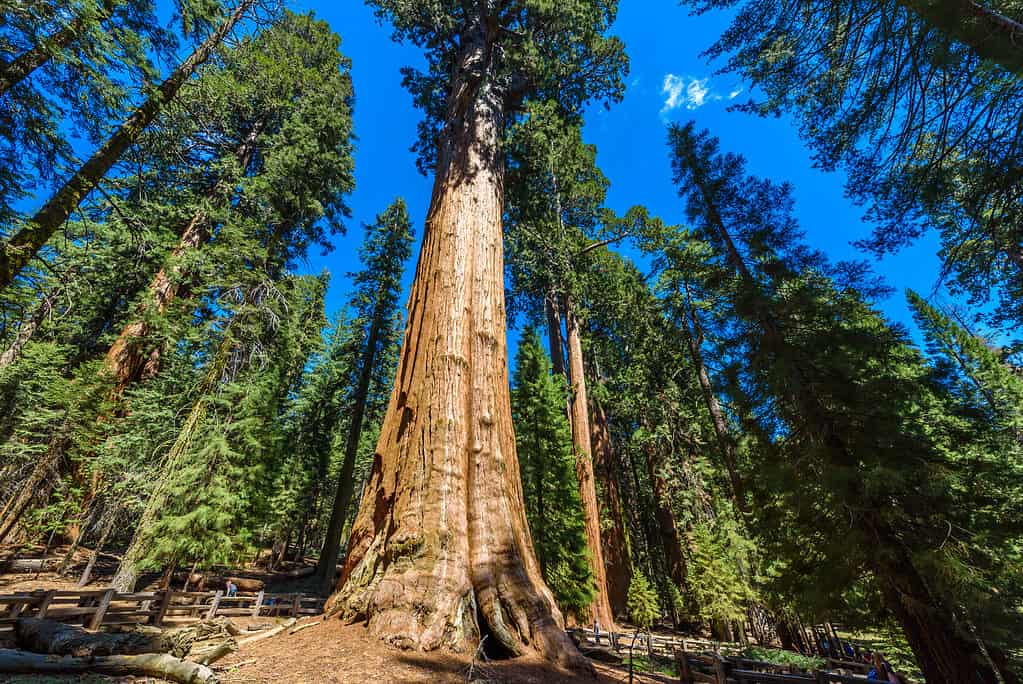
The giant trees of Sequoia National Park offer a stark contrast to the barren land of Death Valley National Park.
©Simon Dannhauer/Shutterstock.com
23 More Parks in Just 5 States
Alaska comes in a close second to California with eight national parks, including:
- Denali National Park
- Gates of the Arctic National Park
- Glacier Bay National Park
- Katmai National Park
- Kenai Fjords National Park
- Kobuk Valley National Park
- Lake Clark National Park
- Wrangell-St. Elias National Park
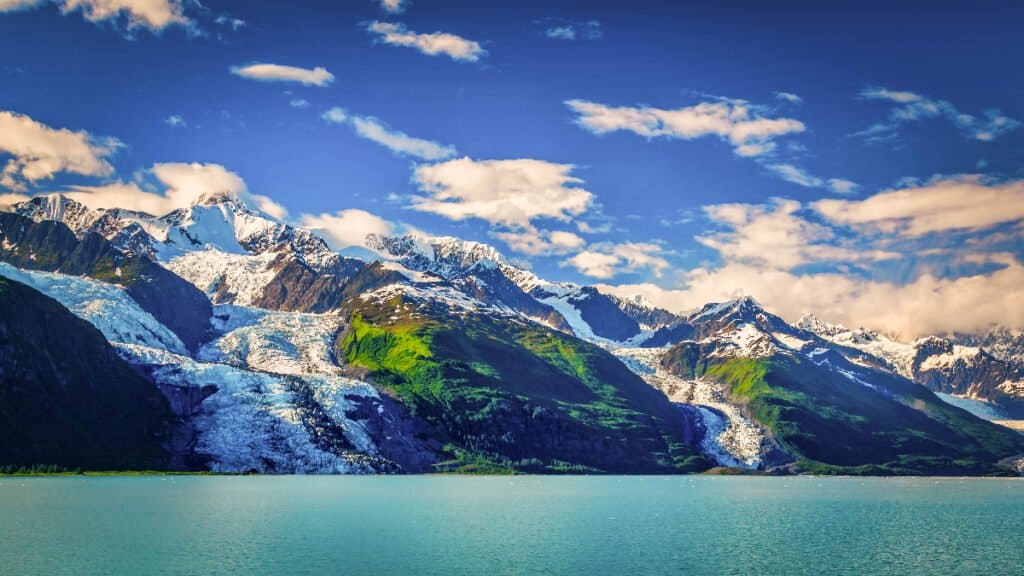
Glacier Bay National Park is one of Alaska’s eight breathtaking national parks.
©aarbois/Shutterstock.com
Utah is next in line with five national parks. They are:
- Arches National Park
- Bryce Canyon National Park
- Canyonlands National Park
- Capitol Reef National Park
- Zion National Park
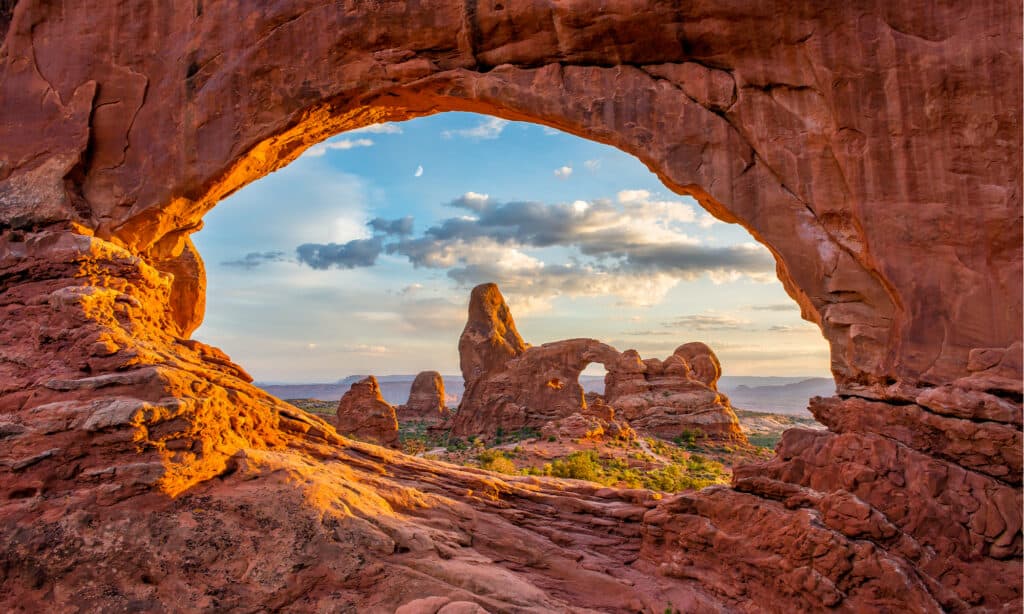
Arches National Park in Utah offers stunning landscapes that practically beg to be photographed.
©anthony heflin/Shutterstock.com
Colorado ranks fourth with four national parks. The parks of The Centennial State include:
- Black Canyon of the Gunnison National Park
- Great Sand Dunes National Park
- Mesa Verde National Park
- Rocky Mountain National Park
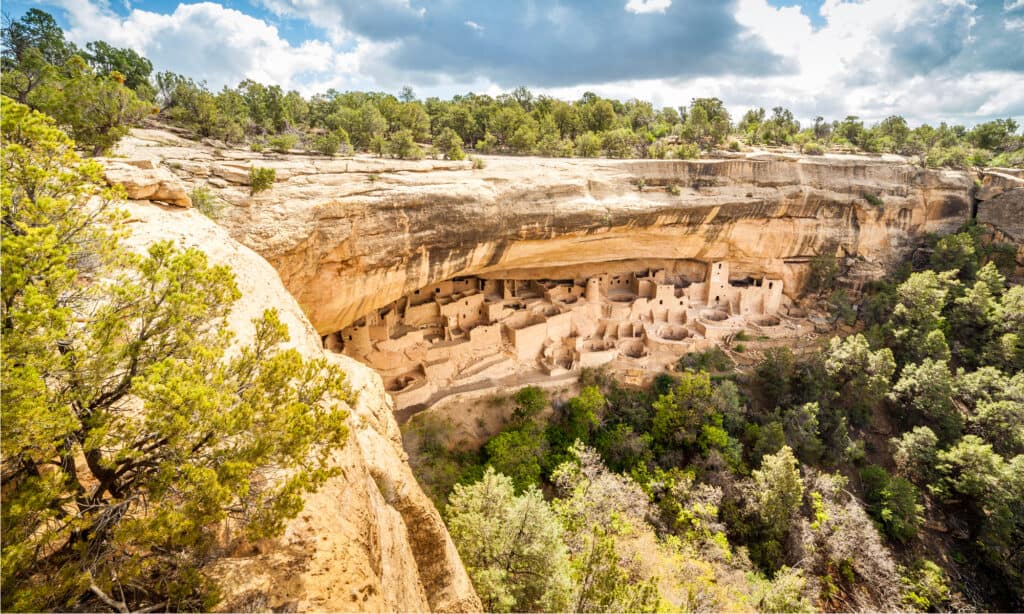
Mesa Verde National Park protects structures built by ancestral Pueblo people on the mesas and in the cliffs of the region.
©Sopotnicki/Shutterstock.com
Arizona and Florida tie for fifth with three national parks each.
Arizona’s three parks are:
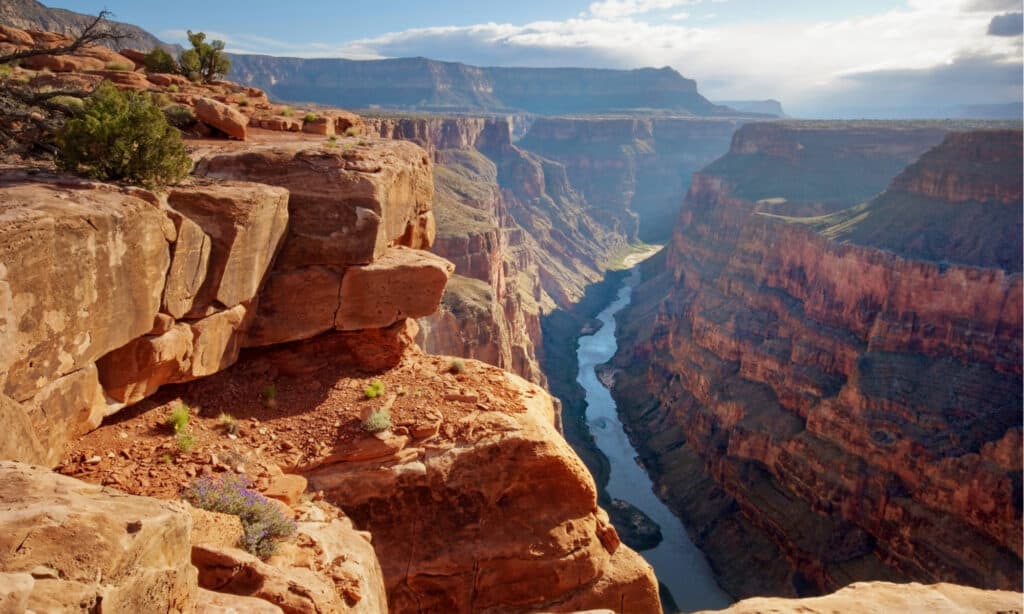
Grand Canyon National Park in Arizona is one of the most famous national parks in the U.S., for good reason.
©sumikophoto/Shutterstock.com
Florida’s national parks include:

Everglades National Park protects the biggest tropical wilderness in the U.S.
©iStock.com/Robert DelVecchio – OcuDrone
Which State Boasts the Largest National Park?
At 570,641 square miles, Alaska is the largest state in the U.S. In fact, Alaska is bigger than the next three largest states combined (Texas, California, and Montana). Given the gargantuan size of the state, it is not surprising that Alaska is also home to seven of the top ten largest U.S. national parks, including the biggest one of them all: Wrangell-St. Elias National Park. This massive park covers 13.2 million acres. That’s the size of six Yellowstones!
This national park is one of the wildest places in the United States. There are millions upon millions of acres with no manmade structures. This untouched landscape looks almost exactly as it has for thousands of years.
The park encompasses four mountain ranges and features some of the highest peaks in the U.S., including Mount Saint Elias at 18,008 feet. More than 25% of the park is covered in glaciers, yet other parts of the park feature volcanic activity. Thousands of lava flows converge in the 2,000-acre Wrangell Volcanic Field.
The park is home to iconic Alaskan animals, including one of the largest concentrations of Dall’s sheep in North America. All three North American bear species (black, brown, and polar) flourish here. Moose roam throughout the park. Bison have been reintroduced after they were nearly extirpated from the park through overhunting in the 19th and early 20th centuries.
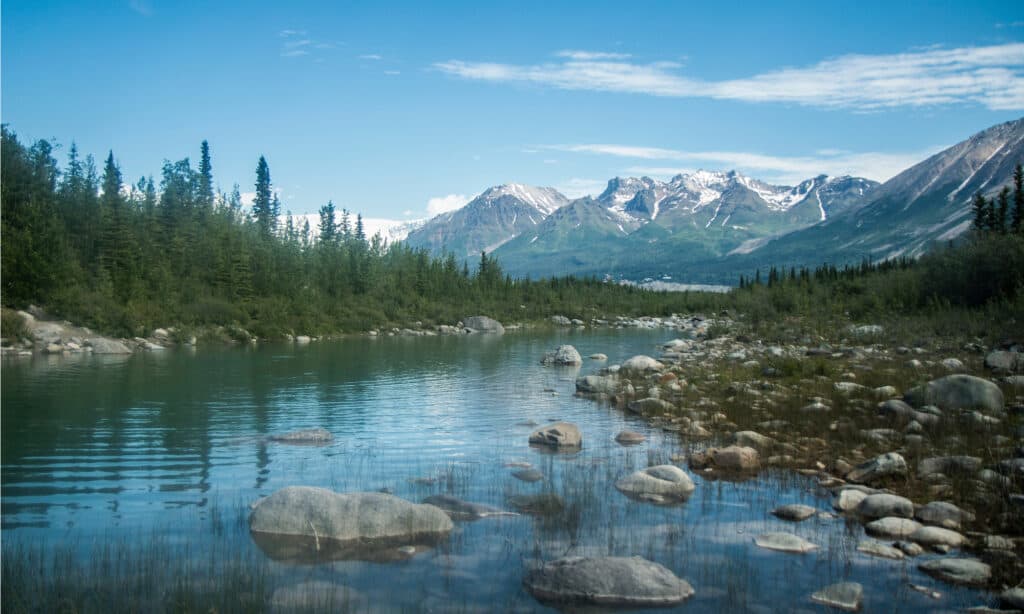
The enormity of Wrangell-St. Elias National Park and Preserve is beyond description.
©BlueBarronPhoto/Shutterstock.com
Where Is the Smallest National Park?
The smallest national park in the United States, by far, is Gateway Arch National Park in St. Louis, Missouri. The entire footprint of the park is only 91 acres, less than two percent the size of the next smallest park, Hot Springs National Park in Arkansas.
Up until 2018, this iconic St. Louis site was known as the Jefferson National Expansion Memorial. It was still managed by the National Park Service (NPS), but it was classified as a national memorial. The name paid homage to Thomas Jefferson’s vision for westward expansion. The site also commemorated the first civil government west of the Mississippi River, as well as the Old Courthouse, where the famous Dred Scott case was heard.
The name of the memorial was changed thanks to bipartisan legislation approved by the U.S. Congress. The legislation to confirm the name change was signed by President Trump on February 22, 2018. The Jefferson National Expansion Memorial officially became Gateway Arch National Park.
Superintendent of the park, Mike Ward, said, “The name ‘Jefferson National Expansion Memorial’ was established long before the Gateway Arch was envisioned, and has simply never been adopted by our millions of visitors.” He also noted, “The mission of the park remains the same regardless of the park’s name.”

Gateway Arch National Park is the smallest national park, and it’s not even close.
©amolson7/Shutterstock.com
More Than a Simple Name Change
Still, the name change was not without controversy. While it may seem like mere semantics to some, the name change also reclassified the area, changing it from a national memorial to a national park.
Along with national parks, the NPS manages national memorials, monuments, battlefields, military parks, historical parks, historic sites, lakeshores, seashores, recreation areas, scenic rivers, and trails.
Some of the more famous non-park sites managed by the NPS include the Statue of Liberty, Devil’s Tower, Alcatraz Island, the National Mall, and The White House.
The renaming and reclassification of Gateway Arch as a national park stirred controversy among many who claimed it was better for the area to remain a national monument. Opponents of the change pointed out the designations set forth by the NPS itself.
According to the NPS, “Generally, a national park contains a variety of resources and encompasses large land or water areas to help provide adequate protection of the resources.”
Meanwhile, NPS points out, “The title national memorial is most often used for areas that are primarily commemorative.”
While visitors to Gateway Arch National Park may not even notice the name change, opponents of the change insist that the park should have remained a national memorial rather than being added to the flagship list of U.S. national parks.
Where Is the Oldest National Park?
Yellowstone National Park is not only the oldest national park in the United States, but it was also the first national park in the world. The origins of Yellowstone as a national park are found in a geological survey funded by the U.S. government in 1871. Geologist Ferdinand Vandeveer Hayden led the survey.
Hayden’s lengthy final report, along with sketches and paintings by Thomas Moran and the photographs by William Jackson, compelled Congress to prohibit the private development of this land. Just six months after the Hayden expedition, the U.S. Congress established Yellowstone National Park. President Ulysses S. Grant signed the Yellowstone National Park Protection Act into law on March 1, 1872. Thus, the first national park in the world was born.
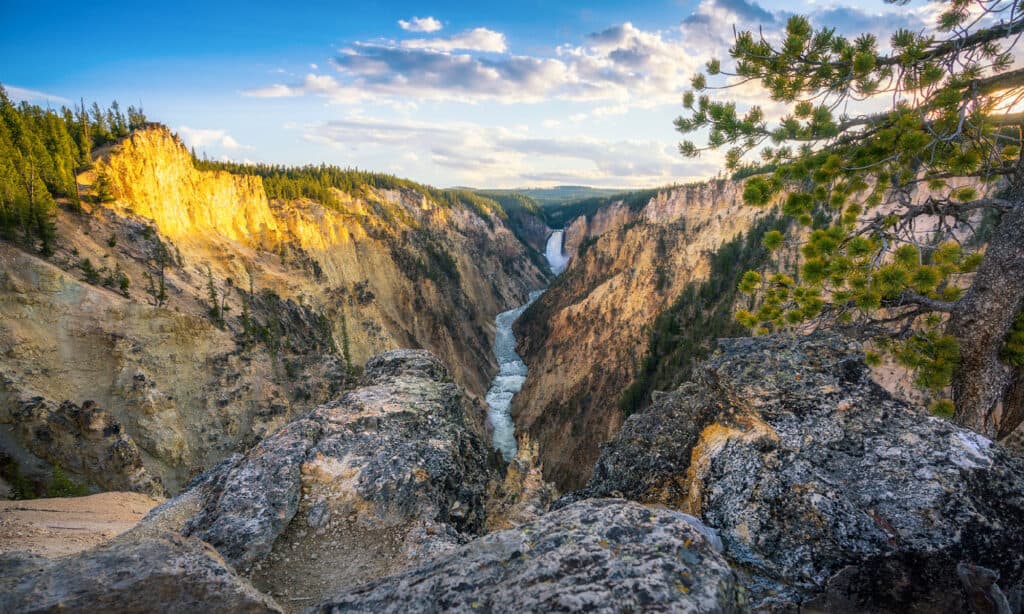
Thomas Moran chose the Grand Canyon of Yellowstone as one of his artistic subjects. His paintings helped spur the advancement of the Yellowstone National Park Protection Act.
©iStock.com/ChrisB
A Park Like No Other
Yellowstone is the only national park shared by three states: Wyoming, Montana, and Idaho. Two other national parks lie in multiple states: Death Valley National Park (California and Nevada) and Great Smoky Mountains National Park (Tennessee and North Carolina).
Yellowstone is the eighth-largest U.S. national park and is one of the largest nearly intact temperate zone ecosystems on Earth. The diverse wonders of Yellowstone include hydrothermal features, including nearly half of the world’s geysers. The park features more than 600 lakes and ponds, as well as geologic wonders like the Grand Canyon of the Yellowstone River.
The wildlife of Yellowstone is as diverse as its landscape. The most famous wild residents of Yellowstone include bison, bears, elk, moose, and wolves, but that doesn’t even scratch the surface of the number of animals that reside in the park.
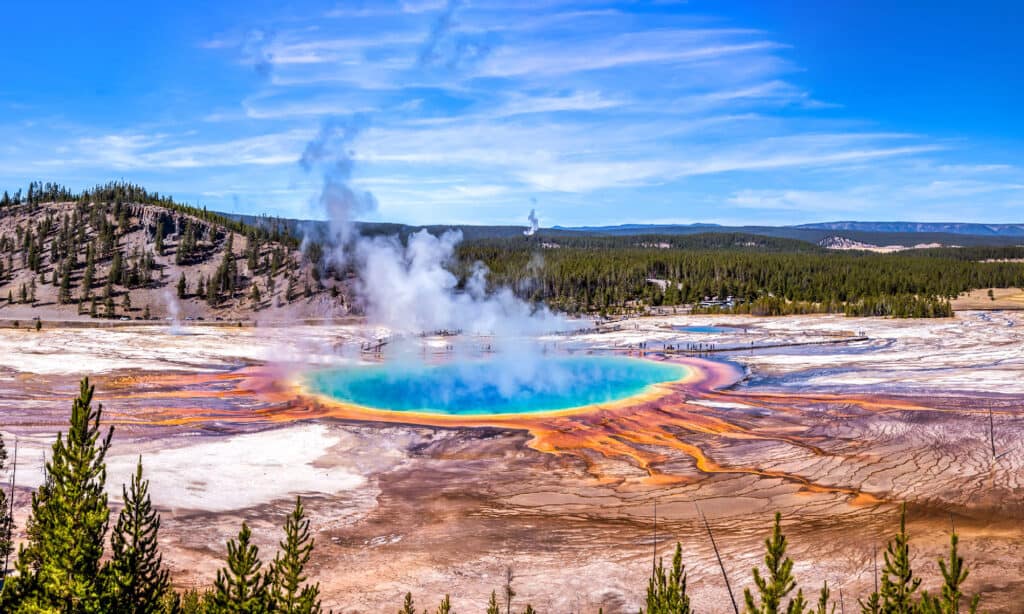
Grand Prismatic Spring is Yellowstone’s largest hot spring. It is also one of the most photographed features in the park.
©Lillac/Shutterstock.com
Which State Is Home to the Newest National Park?
New River Gorge National Park in West Virginia is the newest U.S. national park, receiving its national park designation when President Donald J. Trump signed the legislation on December 27, 2020. The region had previously been designated as a national river, signed by President Jimmy Carter on November 10, 1978.
While the national park designation is new, the area itself is ancient. The New River is not new at all. It is actually one of the oldest rivers in the world and is quite possibly the oldest river in the United States.
The New River begins in the Blue Ridge Mountains and flows for 320 miles through North Carolina, Virginia, and West Virginia. It is one of the very few rivers in the world that flows primarily from the south to the north.
For millions of years, this river has carved its way through the sandstone, creating cliffs that feature world-class rock climbing. The river features Class V rapids, providing some of the wildest and most exciting whitewater rafting in the nation.
The park is also an excellent fishery. Anglers can target bass (smallmouth, largemouth, striped, and rock), walleye, muskellunge, crappie, bluegill, carp, and catfish (flathead and channel).
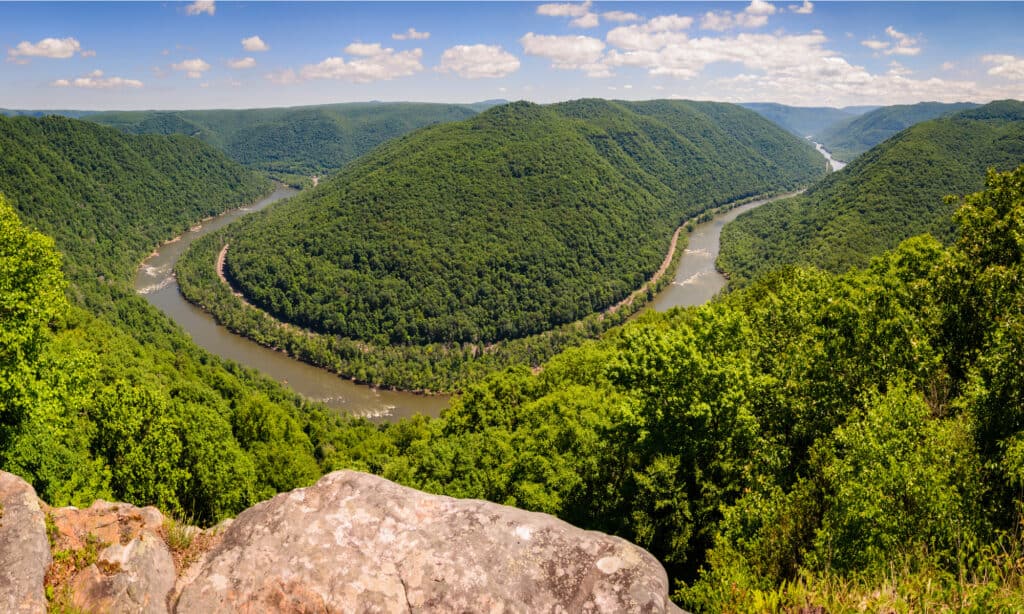
New River Gorge National Park and Preserve is the newest national park, but the river is possibly the oldest in the U.S.
©Zack Frank/Shutterstock.com
Where Can You Find the Most Visited National Park?
Great Smoky Mountains National Park is the most visited national park in the United States by a wide margin. The park welcomes around 13-14+ million visitors each year. The next busiest park, Grand Canyon National Park, sees 4-5 million annual visitors.
The most popular month for visitors to the park is October, when leaf-peepers come in droves to view the park’s stunning fall foliage. The second most popular month is July, when most schoolchildren are on summer vacation.
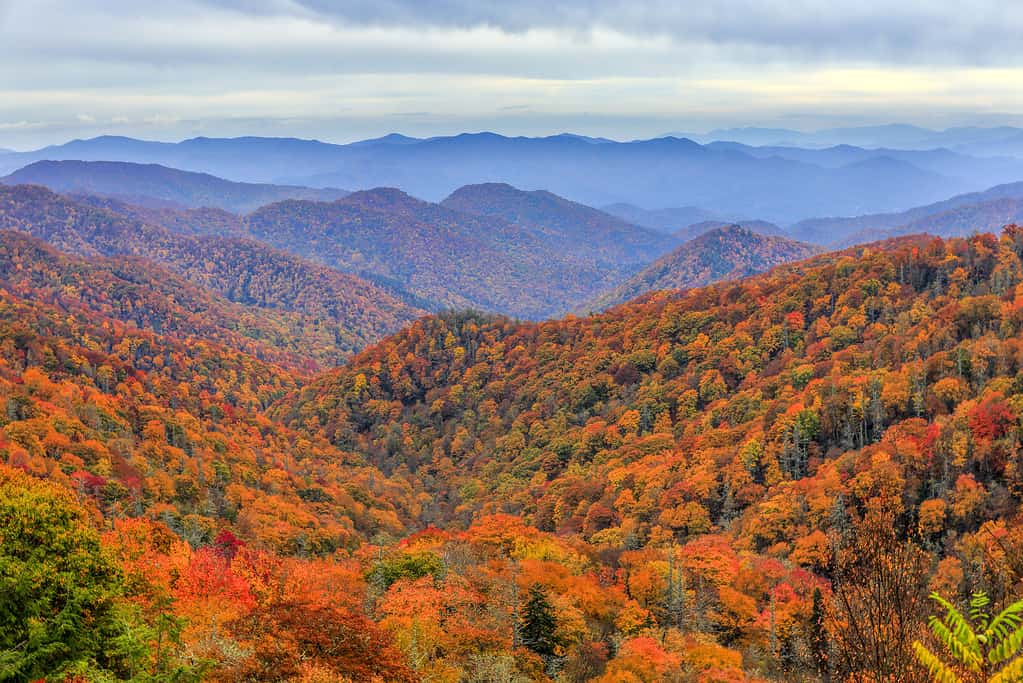
The stunning autumn colors in the Great Smoky Mountains National Park make October the busiest month in the park.
©iStock.com/Sean Board
Why Is GSMNP the Most Visited Park?
There are multiple reasons for the high number of visitors to the park each year. One very simple reason is the park is one of the few national parks that does not charge an entrance fee.
A second reason for the high number of visitors is the park’s location. About two-thirds of Americans live within a day’s drive of the park.
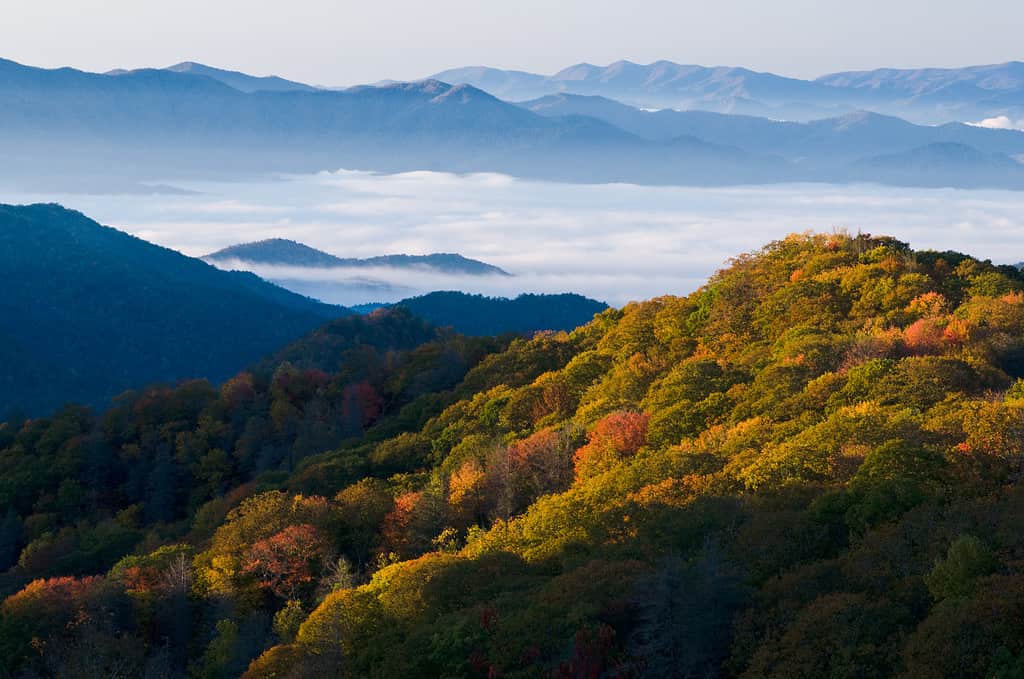
The vistas of the Great Smoky Mountains National Park are among the main reasons why the park is the most visited.
©iStock.com/gelyngfjell
The third and most important reason for the number of visitors is the park itself. The Smokies are filled with beauty and history, and much of it is easily accessible. Cade’s Cove, for instance, is the most visited site in the most visited national park. This verdant valley features an 11-mile loop road accessible by any vehicle. Visitors to Cade’s Cove enjoy mountain views, structures built by early residents of the Cove, and lots of wildlife. Wild turkeys, white-tail deer, and black bears are all common sightings in Cade’s Cove. Black bears are the national park’s most famous animal, with some 1,500 bears residing in the park.
For those wishing to avoid the crowds, the North Carolina side of the park is quieter and less crowded than in Tennessee. Sightings of elk reintroduced to the park in 2001 are very common on this eastern side of the park.
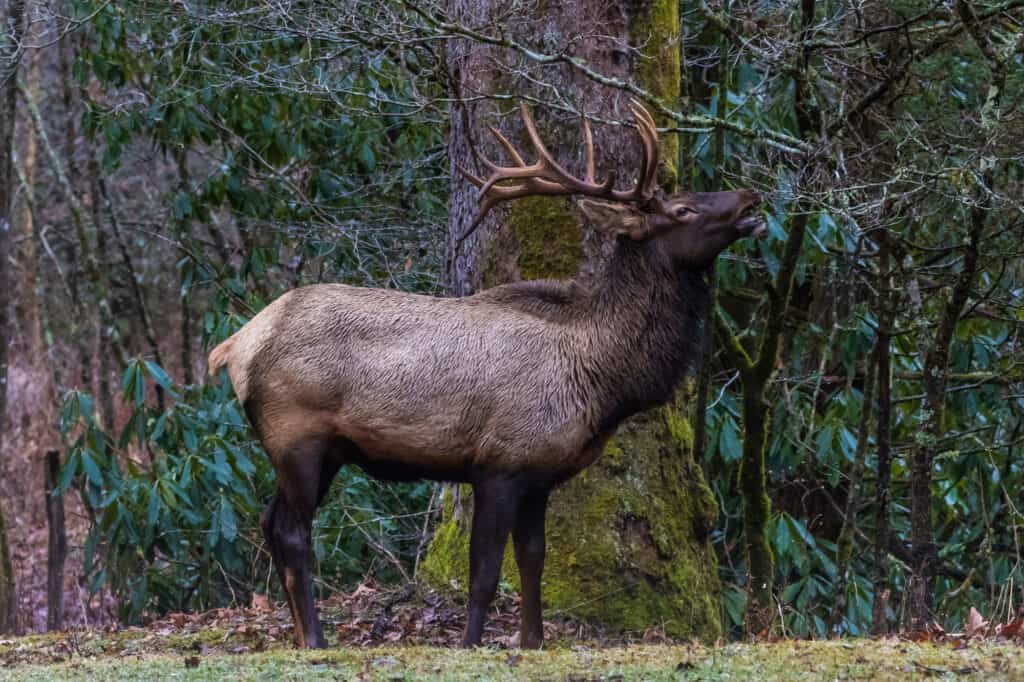
Elk are now widespread in Cataloochee Valley on the North Carolina side of the national park.
©iStock.com/DimitrisTimpilis
A Park for Everyone
The park features paved trails where young parents can easily push a stroller, but also rugged mountain trails that will test expert hikers. There are front-country campgrounds that can accommodate large RVs, and backcountry campsites that require miles of hiking to access.
There really is something for everyone in this national park, which is why it draws more visitors than any other.
Which State Has the Least Visited National Park?
The national park that welcomes the fewest visitors each year is Gates of the Arctic National Park & Preserve in Alaska, with guests numbering 7,000-8,000 annually.
The park lives up to its name. It certainly is the gateway to the Arctic. It is the second-largest of the national parks at 8,472,506 acres. The entire park lies within the Arctic Circle. In fact, the coldest temperature ever recorded in the United States was recorded in nearby Prospect Creek.
There are no roads, trails, or amenities of any kind in the park. It is completely and utterly wild. Anyone who explores the park must be completely self-sufficient, including being well-versed in outdoor survival skills.
Guided day trips are available, including fishing excursions where anglers can fish for arctic grayling, the most populous fish in the park. Flightseeing tours are the most popular way to view the park’s arctic landscape.
Caribou abound in the park, as do brown bears, muskoxen, and Dall’s sheep. The aurora borealis often lights up the sky in a dazzling display.
The few visitors who do make their way to Gates of the Arctic National Park are in for an experience they will never forget.

Gates of the Arctic National Park has no manmade amenities whatsoever.
©BlueBarronPhoto/Shutterstock.com
Two Additional National Parks That Aren’t in a State
There are two national parks not located in a U.S. state, but rather in the U.S. territories of American Samoa and the U.S. Virgin Islands. Though they are not as well known, the National Park of American Samoa and Virgin Islands National Park are just as much a part of the U.S. National Park system as any of the parks in U.S. states.
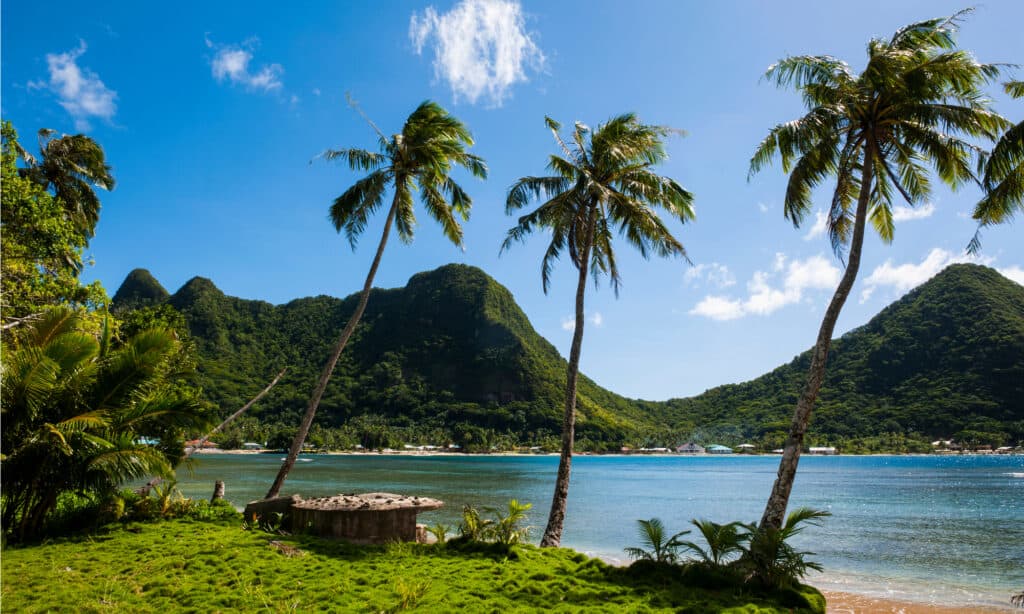
The gorgeous views in the National Park of American Samoa are seen by relatively few people. It is the second-least visited national park.
©Danita Delimont/Shutterstock.com
What About State Parks?
There are 6,792 state park units in the United States, and they see 813 million visitors. So, state parks are a significant factor in the recreation and historical education of Americans. Here are some interesting facts about state parks:
- The largest state park is Anza-Borrego Desert State Park in San Diego County with 585,930 acres.
- Adirondack Park, with about six million acres, is the largest park in the continental U.S. and all 50 states, but it is actually an area of forest preserve containing 102 towns/villages and includes private properties.
- The largest state park system in the United States is Alaska State Parks, with over 100 sites encompassing 3.3 million acres.
- California has the most state parks in the country, with 270.
- There are 11 states with more than 100 state parks each.
- Rhode Island comes in last with just 15 state parks..
The photo featured at the top of this post is © iStock.com/TravelShotz
Thank you for reading! Have some feedback for us? Contact the AZ Animals editorial team.






